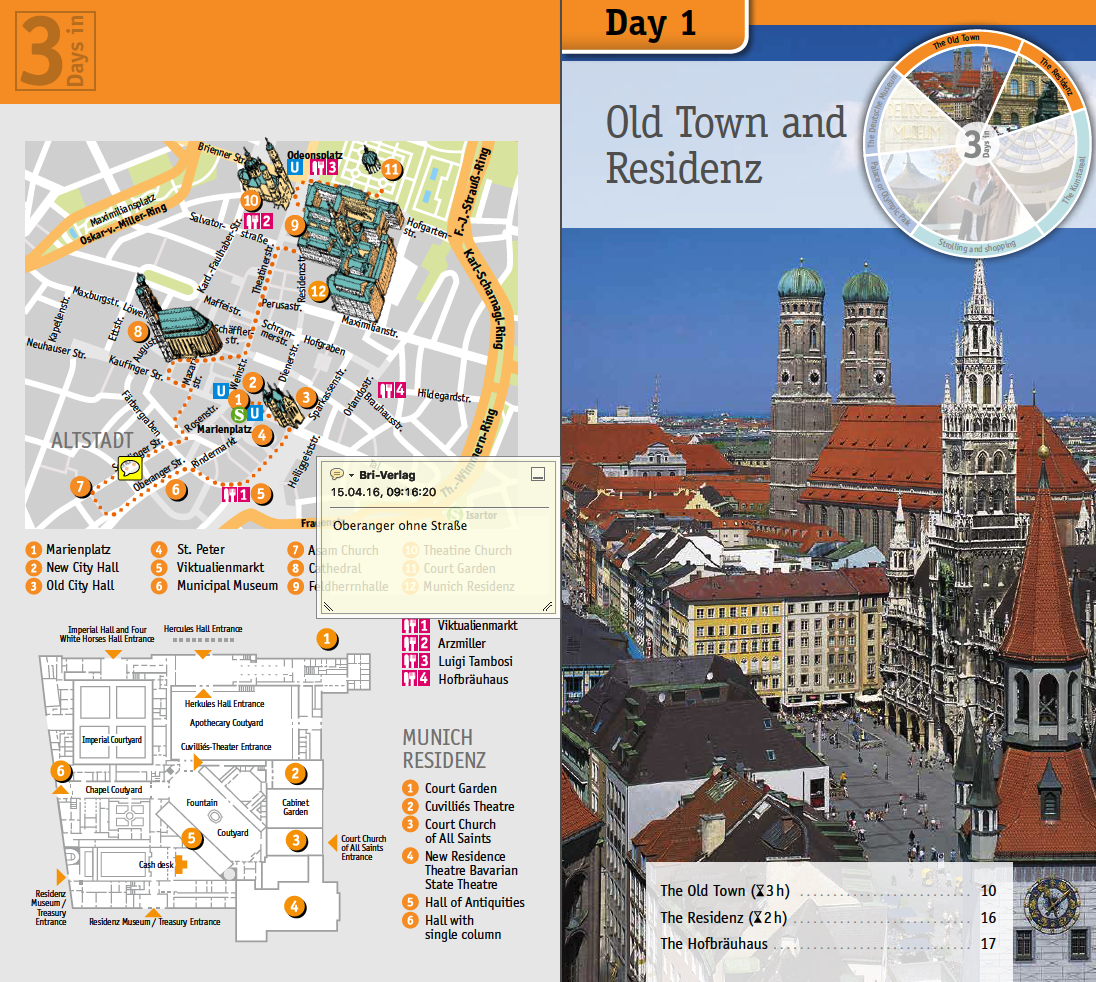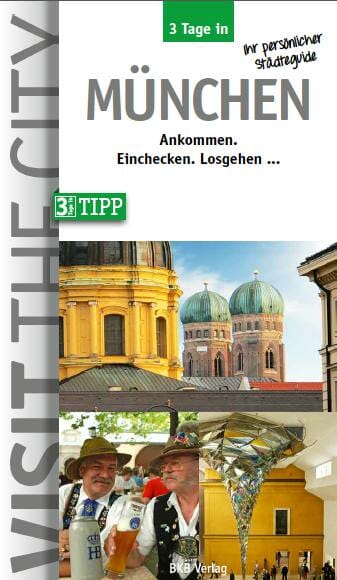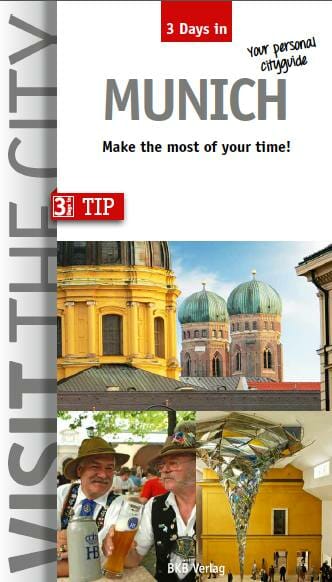MUNICH – THE BAVARIAN CAPITAL
TIPS FROM THE VISIT-THE-CITY EDITORS
FOR YOUR 3-DAY TRIP TO MUNICH
Munich is so diverse it’s difficult to know if you are in a metropolis or a huge village. Sometimes Munich is a magnificent and stylish cosmopolitan city, sometimes it offers up a tranquil idyll. Sometimes it is brightly coloured and brash; sometimes it dons conservative blue and white checks. But whether Komödienstadl or Opernfestspiele, Maximilianstraße or Schwabing, brewhouse or night club, veal sausage or nouvelle cuisine, it is precisely Munich’s many faces, its extremes, which make the city on the Isar River so full of life, constantly inviting you to make new discoveries.
The texts and images on our website are to help you get your bearings and plan your trip to Munich. All information have been carefully researched by the 3-Days-in editorial team and they are continually updated. Nevertheless, it is possible that individual details are incomplete or out of date. We are therefore grateful for every correction or addition to our information. Please send your hints to: info@3-tagein.de
Find more detailed information in our travel guide “3 Days in Munich”, which you can buy as a paperback or e-book in the BKB Shop or from your bookstore!
THE BKB TRAVEL GUIDE
You will find more detailed information in our travel guide “3 Days in Munich“: A schedule for three days, a city map, special tips and the BKB address service. We will show you the highlights, walk with you into nice quarters, have a break and tell nice stories … just as much as you need for three days! Order the travel book “3 days in Munich” as paperback or e-book right here in the BKB Shop or in your bookstore!
BY PLANE OR TRAIN – IT IS EASY TO COME TO MUNICH

You can fly to Munich with many airlines. The Munich Airport is about 28.5 kilometers northeast of Munich in the Erdinger Moos near the city of Freising. There is a MUC Airport app, which can be downloaded free of charge from iTunes and Google Play. It provides you with up-to-date status reports on departures and arrivals. The S-Bahn lines S1 and S8 run between Munich city center and the airport every 10 minutes. You can easily reach the airport by bus from Munich city center, Ingolstadt and Landshut. The bus stop is just a few steps beside Terminal 2.
Find your flight connections right here:
By train you can travel to Munich easily from many countries in Europe. Due to the central location of the main station, a visitor is right in the middle of the city. All major suburban trains and bus lines stop there.
Click here to search for your right connection:

MUNICH DAY 1
VIKTUALIENMART: COME IN TOUCH WITH THE PEOPLE
This is a real must: whether oysters or “Hendl” (chicken), local mushrooms or exotic fruit, at Munich’s largest and oldest food market (since 1807) every culinary wish will come true and everybody finds a “Schmankerl” (titbit) to suit their taste. On the 22,000 square metre marketplace, the day begins at 5 am when the market traders offer a range of food from their stalls, attracting both night owls and early risers.


CENTER OF OLD TOWN – MARIENPLATZ
The New City Hall dominates the square with its richly decorated neo-Gothic façade. The famous glockenspiel in the broad central tower is not to be missed; it chimes at 11 am and noon (from March to October also at 5 pm), and portrays scenes from the city’s history: above, a tournament commemorates the wedding of Duke Wilhelm V and Renata von Lothringen in 1568, while below, the Shepherds’ Dance recalls the plague. At 9 pm the Münchner Kindl is brought to bed by a horn-blowing nightwatchman and an angel.
THE CHURCH OF OUR LADY
With its onion-like, exotic Latin domes, visible from far and wide, the Gothic brick-built Frauenkirche, whose official name translates as the Cathedral Church of Our Lady, is the emblem of the city. Thanks to many donations and numerous indulgences, the master builder Jörg von Halspach, commissioned by Duke Sigismund, took only 20 years (1468–1488) to complete the basilica which has a nave and two aisles. Its capacity is 20,000 (Munich had about 13,000 inhabitants at that time). In the interior, visitors can marvel at such historical treasures as the cenotaph of Emperor Ludwig of Bavaria (1622) in the first bay of the southern aisle, the silver bust of St Benno in the Benno Chapel, or the family vault of the Wittelsbach royal family behind the chancel.


AT LUCIFER’S FOOTPRINT
The footprint in the entrance area is said to be proof that Jörg von Halspach was able to cope with the construc- tion work only with the help of the devil himself: they allegedly made a pact that the church would remain windowless In this way the devil hoped he could prevent people from attending church When, however, he saw the faithful stream- ing into the place of worship after its com- pletion, he demanded the soul of the builder Jörg von Halspach led him to a point from which no window can be seen – the mighty row of pillars covers the aisles and the high altar hides the choir window In his anger the devil stamped the ground with such force that an impression of his foot remained in the marble …
THE RESIDENZ – HOME OF THE WITTELSBACH FAMILY
The imposing palace complex, which until 1918 served as a residence and seat of government for the Wittelsbach family, was created over the course of several centuries. Its origins lie in a moated castle from 1385, which each ruler extended, furnished and had decorated by artists of his time. For this reason there are three main complexes of correspondingly varied styles: they exhibit a mixture of Renaissance, Baroque, Rococo and Classicism. Visit the four bronze lions which stand guard over the Residenz at the entrance to Residenzstraße, andstroke their shiny noses Doing this is said to bring luck!
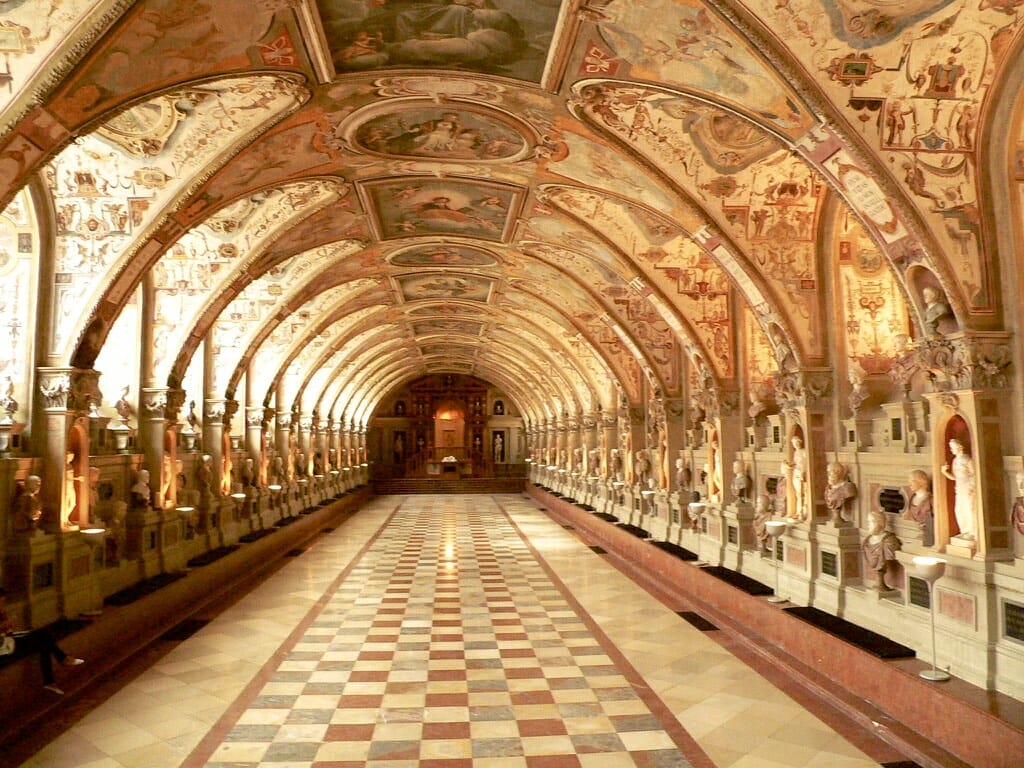

THE COURT GARDEN
An archway entrance (Hofgartentor), Leo von Klenze’s first edifice in Munich (1816), leads into the Court Garden (Hofgarten), which was laid out at the beginning of the 17th century and modelled on Italian Renaissance gardens. Today it is a green oasis in the midst of the hustle and bustle of the city centre. In its centre stands a pavilion with a wall fountain adorned with four mussels; the pavilion’s eight entrance arches define the way the garden is divided by means of crossing diagonal paths.
Have a break at Luigi Tambosi, the 200 year old coffee house which serves meals outside in the Court Garden.
MUNICH AT NIGHT
Not only the Hofbräuhaus, the famous beer gardens or the Oktoberfest itself, Munich offers a wide range of places for entertainment. The best-known entertainment quarter is the area around Münchner Freiheit in Schwabing, even if the wild years are long gone. Because of the curve in the street, Altstadtring between Maximilianplatz and Sendlinger Tor along with its many clubs and bars is known as the “party banana”. The top location for partying is Sonnenstrasse, where the nights are long in locations such as the electro-club Harry Klein, the Cord Club or Jack Rabbit. South of the Sendlinger Tor, things are a little quieter. In the surrounding streets there are many cafés, pubs, bars and restaurants. The area around Müllerstrasse is home to Munich’s gay and lesbian scene. In the industrial zone by the Ostbahnhof, where once the legendary Kultfabrik had its big party area, a new quarter called Werksviertel is emerging. At its heart is Werk 3, a site where once the food manufacturer Pfanni made potato products and now the night owls come to have a good time.

MUNICH DAY 2

MEET THE FINE ARTS
Königsplatz is Munich’s most beautiful Classical square, on which Leo von Klenze created a complete work of art in the form of an ancient forum with the Glyptothek, the State Antique Collection and the Propyläen and in so doing presented a piece of Greece to King Ludwig I. In summer, the square is transformed into a concert arena. The Doric Propyläen is intended to commemorate the fight for freedom of the Greeks against the Turks, as a consequence of which Ludwig’s second son Otto was proclaimed king of liberated Greece. The spectrum of exhibits displayed in the museums around Königsplatz ranges from antiquity to the modern age.You’ll have to make a strong personal selection.
PINAKOTHEK OF MODERN ART
This house is one of the largest museums for 20th and 21st-century art in the world which since its opening in 2002 has attracted many visitors: on over 12,000 square metres, four important collections – art, design, works on paper and architecture – are presented in the spacious building whose design, by architect Stephan Braunfels, means that it is flooded with light. Indeed the museum itself is a work of art. On the ground floor the Staatliche Graphische Sammlung (State Collection of Prints and Drawings) presents its collection in constantly alternating exhibitions. Works by Beckmann, Warhol, Picasso and Beuys are exhibited in the first and second floors in the collection of modern art. The new collection, which counts as the first ever design museum, illustrates the history of design. Exhibitions on historical and forward-looking architecture are presented by the Architecture Museum of the TU Munich.


THE ENGLISH GARDEN – ENJOY YOURSELF
It is the green oasis in the heart of the city and popular with young and old alike. With a total area of 373 hectares the English Garden is larger than Central Park in New York and one of the largest inner-city green spaces in the world. Paths extend 78 kilometres throughout the park; moreover there are 12 kilometres of bridle paths and 8.5 kilometres of flowing water. Right beside the lake is one of Munich’s nicest beer gardens in which you can enjoy a cool Maß along with Schmankerl (snacks), both large and small
STROLLING AND SHOPPING
Whether haute couture or way-out outfits, Bavarian garb or funny accessories, Munich’s shopping mile is an eldorado for those born to shop. The epitome of luxury: Maximilianstraße. A stroll along the classy street between the National Theatre and the Altstadtring, a stretch which numbers among the most expensive shopping streets in Europe, is surely an obligatory item of the itinerary of any visit to Munich. You will find row upon row of exclusive designer shops, jeweller’s and galleries. Further well-known fashion designers such as Etro, Versace, Armani and Dolce & Gabbana have taken up residence in the Maximilianhöfen (Maximilianstr. 11-15).

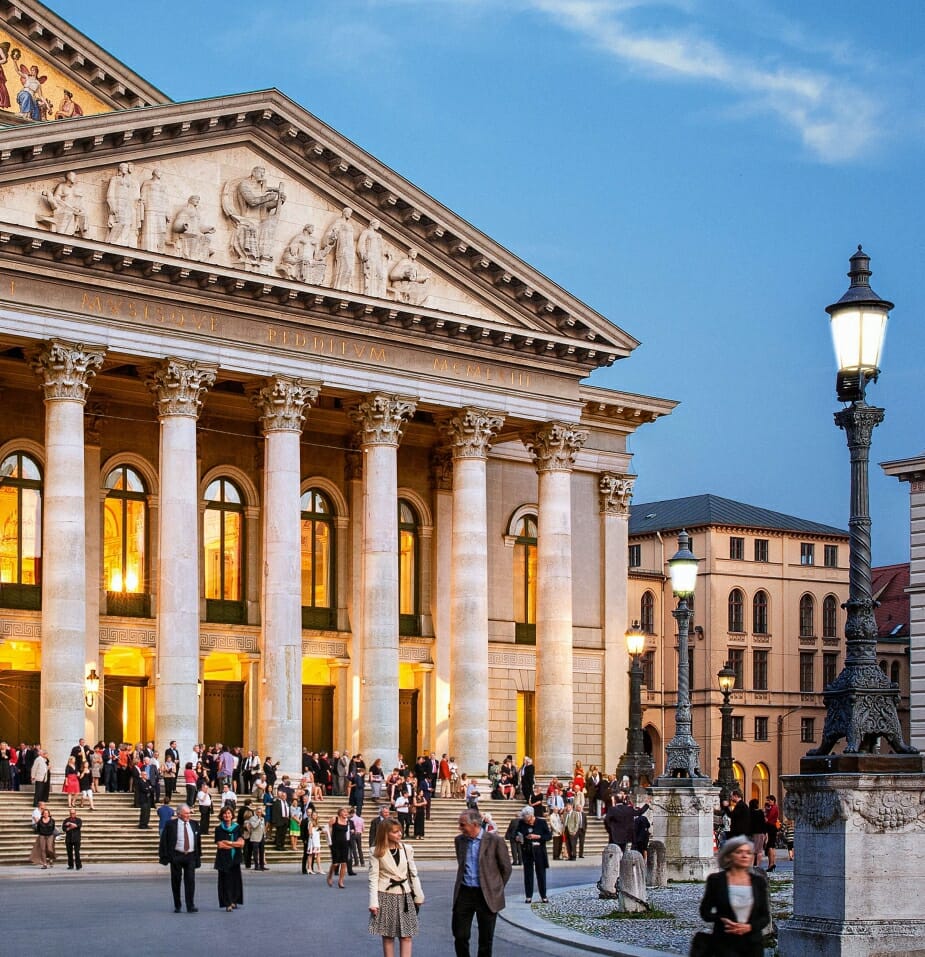
AN EVENING OUT
If you plan to spend your evening in Munich with a programme of culture, you are spoilt for choice. With five state, three municipal and more than 50 private theatres, the city has a huge range of alternatives for drama, ballet and opera. The Bavarian capital has something for every taste, from a performance at the Bavarian State Opera in Germany’s largest opera house and a concert given by the Munich Philharmonic Orchestra or the Philharmonic Choir in the National Theatre to a play on the stage of the Bayerisches Staatsschauspiel (Bavarian State Theatre), the Münchner Kammerspiele (Munich Chamber Theatre), popular theatre and comedy at the Bayerischer Hof, or the satirical cabaret of the Münchner Lach- und Schießgesellschaft. If you like, you can book tickets in advance:
MUNICH DAY 3
HIGH TECH AND LEISURE TIME – THE OLYMPIC PARK
In more than four decades the Olympic Park has lost none of its attractiveness. Thanks to the combination of green open spaces and areas for sporting and other events it is not only a tourist attraction but also a popular leisure area for the people of Munich. Every year, five million visitors come to the park (not including joggers and strollers) to admire the outstanding architecture, attend one of the numerous events or to take part in sports. One of the park highlights is the tent-roof tour. Equipped with a rope and a carabiner, you will be in a small group at dizzying heights. You will hear interesting facts about the architecture and construction of the Olympiastadion and you can enjoy the overview. And those who like, glides with Europe’s longest Flying Fox 200 meters across the arena the Olympiastadions!


NYMPHENBURG CASTLE…
This excursion is only worthwhile on sunny days: those who wish to experience the pleasant life of an electoral prince in his summer residence should pay a visit to the expansive Baroque palace site with its large park. The birth of the heir to the throne Max Emanuel was the impetus for the construction of this summer palace, presented by Elector Ferdinand Maria as a gift to his wife Henriette Adelaide. Max Emanuel and his successors then had the site extended to become a spacious and charming palace in which every architect and artist who was anybody had a hand.
… WHERE PINCES SPENT THEIR SUMMER TIME
Visitors are overwhelmed by the elaborately furnished interior with stucco, gold, tapestry and paintings in the style of the Rococo and Baroque. The Stone Hall, the large banqueting hall in the central pavilion with lavish gilded stucco decoration and numerous frescoes is an absolute Rococo pièce de résistance. It is most relaxing to stroll through the beautiful palace grounds with its old stock of trees, land- scaped by Friedrich Ludwig von Sckell in the 18th century as an extensive park modelled on those in England.

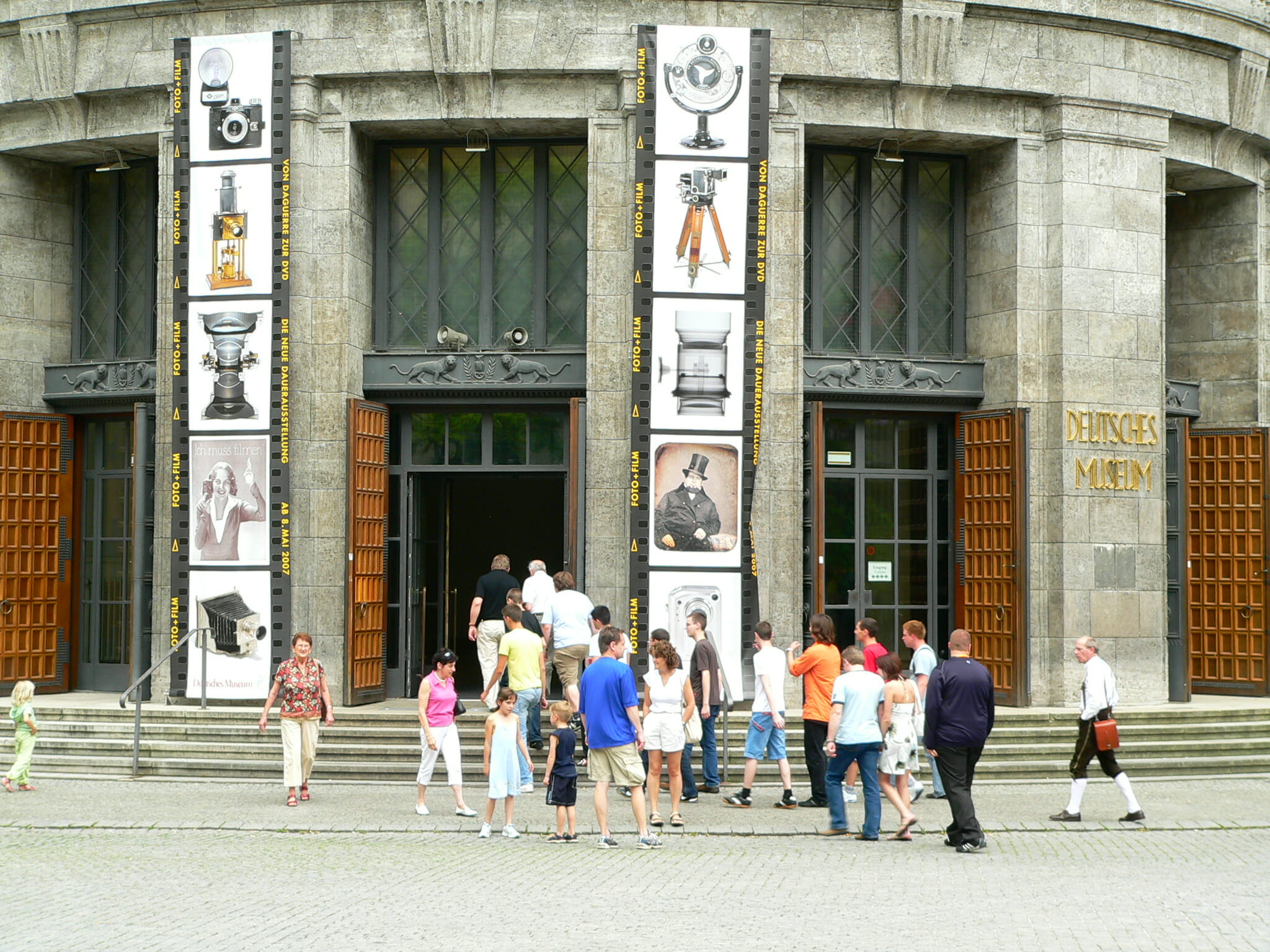
THE DEUTSCHE MUSEUM
With around 45,000 square metres of exhibition space and about 28,000 exhibits, the Deutsche Museum is one of the largest science and technology museums in the world. Anyone wishing to visit all 53 departments would have a 17 kilometre walk ahead of them! The museum has stayed true to the objectives of its founder, namely to impart scientific and technological knowledge to the interested layman in an understandable and, where possible, a vivid, lively way. From the beginning Oskar von Miller, who founded the museum in 1903 wanted to make technology a hands-on experience: with the push of a button, visitors can start experiments through which laws of nature, instruments or technical processes are made understandable.
STROLLING AND SHOPPING IN A FANCY QUARTER
The Glockenbach quarter between Viktualienmarkt, the bank of the Isar and the State Theatre is known as a trendy and buzzing area. Here, numerous small shops, fashion stores and galleries are to be found amongst the cafés, pubs, restaurants and bars.


